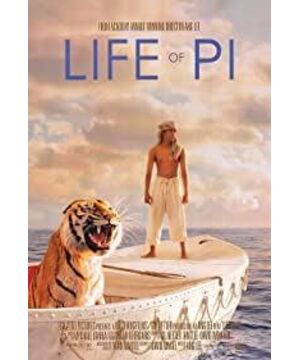-The correspondence between the four animals and the cook, the sailor (the Buddhist who rejoices), the mother, and Pi
-Pi and The duality of the Bengal tiger: good vs. evil, rationality vs. impulse, ethics and morality vs. survival instinct, humanity vs. animality, superego vs. id, or post-traumatic psychological projection, Pi's self-defense mechanism ?
-The metaphor of Cannibal Island: the Hindu god Vishnu? Religion itself? Or even the corpse of Pi's mother with heavy taste?
-The symbol of the meerkat: a mob that has been institutionalized by society? Insensitive religious believers? maggot?
...... ......
These deconstructions are certainly interesting, but the novel author Yann Martel and director Ang Lee did not want to spend years trying to figure out the word puzzles. After these fragmentary symbolic elements, they must have some big theme to express. When we deconstruct these movie elements, we must be able to construct a larger proposition.
In Chai Jing’s dialogue with Li Ang’s "Seeing" program, they said this:
(Li Ang) So I think innocence is very important, so the child in his story is a sixteen-year-old, not twelve, nor twenty-six. age. In general, what is the meaning of your existence at the beginning, he started to use his brain...
(Chai Jing) What was your attitude when you were in this film?
(Li An) It is the growth of a boy, from a boy to a man, what he needs to face.
(Chai Jing) What do you want to convey?
(Li An) It’s a kind of sentiment, I am more sentimental, so I feel that growing up, I have pain in it, which is pure loss...
(Chai Jing) It seems that most of your movies are talking about pure loss .
(Li An) Yes, innocence is not just a loss. Your nostalgia for innocence is a kind of feeling in itself. I think that kind of nostalgia cannot be lost...
(Chai Jing) What has this movie made you discover about yourself?
(Li An) It's hard to tell. It's really hard to tell. I find that I want to send. I think I still have a yearning for faith, but I still have that tiger in my heart, and I still can't figure it out.
(Chai Jing) What is this tiger to you?
(Li An) I can't talk about this.
(Chai Jing) That kind of roaring desire?
(Lee An) No, I can't tell, it's like a wild beast, it's not roaring, it's a kind of wildness.
(Chai Jing) Then do you think the Bengal tiger in your heart has left after making this movie?
(Li An) It's like the causal relationship that Buddhism talks about. If you want to leave, it's best not to even think about it. The more you think about it, the deeper you think.
Based on this, I think the story of "Juvenile School" mainly presents the growth process of a person's inner life. And because religion, philosophy, and psychology are more or less related to this, it is natural to involve these elements in the story.
For the inner confusion, when he was a child, Pi turned to religion. What is existence? Where does good and evil come from? How can I get inner peace? I think this may be part of the doubts that rolled in Pi's heart, and it is also a fleeting trouble for everyone in the process of growing up. However, religion did not give a satisfactory answer, otherwise Pi would not be moved from one religion to another.
The tiger in the film represents the dark side that people often don't want: animality, instinct, impulse, violation of ethics... the so-called "evil" level. "I can't talk about this," Li Ang said.
The three religions Pi comes into contact with their concepts of good and evil are as follows: Monotheistic Christianity and Islam are actually religions of the same origin. They believe that "good" originates from the creator God, and "evil" is due to human pride and disobedience. The original sin arising from the word of God. People are born guilty, and the way to eliminate sin is to turn to God (Jehovah, Allah), and the intermediary for salvation is Jesus, the prophet Muhammad, who represents God. Polytheistic Hinduism believes in reincarnation, because of the existence of evil, life has to go through six reincarnations and cannot escape suffering and enjoy happiness. They call "evil" "karma", that is, karma, karma. The way to liberate is to observe the precepts and practice concentration. (Buddhism has inherited many Hindu thoughts, and has brought forth the new. It proposes to cultivate wisdom on the basis of precepts and samādhi in order to be enlightened, break the cycle of rebirth, and enter Nirvana.)
Although the specific teachings are different, these three religions all hold a negative attitude towards "evil", hoping to eliminate the evil in human nature through a certain method and way. In peacetime, this sounds okay. Believe everything is good. After all, the origin of religion is not only the primitive man’s confusion of natural phenomena, but also the role of ethics, morality, norms, and laws among clans and tribes, ensuring peace between people and benefiting them. The survival and reproduction of the entire group.
However, in the extraordinary period of life and death, everything is beaten back to its original shape-when the social environment is absent, the instinct to survive becomes the driving force that governs everything in the face of personal life and death. Although the distinction between good and evil is still preserved in reason, the primitive animality-the tiger-has broken out of the cage, not for anything else, just to live!
At this time, the religion's definition and restraint of good and evil appear pale and weak, and facing the fierce tiger in his heart, where good and evil are at war, Pi is struggling. At first, he wanted to eliminate the tiger (evil), which was the most common choice and the result of social moral education. However, it didn't work! It's useless! He was frustrated and terrified. Just like Ang Lee said, "it can't be done"!
Then, he had no choice but to compromise. Let evil exist and learn to get along with it. Over time, he discovered that "evil" is not as corrupt as he imagined-is there anything wrong with seeking survival? In order to survive, humans can slaughter livestock and drink blood in peacetime. This seems to be a matter of course. And the reason why you can’t eat or kill people is sinful, because if I eat you, you eat him, he eats me... The human group will soon be over. Therefore, although in primitive society, there was indeed the phenomenon of cannibalism, it was gradually prohibited by the ethics and became a forbidden zone for "evil". However, in the extraordinary period of life and death, Pi had to bow to survival. Of course, he can also choose to starve himself to death for the sake of morals, but he chooses to survive as much as possible. Is there anything wrong with this?
By this time, the so-called boundary between good and evil has been blurred. The reason why it is blurred is because there is no such boundary. Good and evil are not things set by so-and-so gods as claimed by the three religions, nor are they inherently inherently righteous. They are just artificial definitions in the process of human civilization, defined to protect the entire group from The erosion of personal desires, which can then continue to exist-is to limit the instinctive desires of individuals in exchange for a better existence of the group.
When Pi slowly experiences this level, the tiger does not appear so "evil" and should be eliminated. In fact, "evil" (best, animal, desire, instinct) has never been eliminated. It has always been the life of everyone. Part of it. If evil-these primitive impulses and instincts are eliminated-human beings will also lose their vitality. Good and evil are the pros and cons of the same human coin. They are opposites and one. In human society, even for those who are so-called religious figures, the "evil" has only been hidden, suppressed, transformed, and sublimated, rather than eliminated.
Therefore, all Pi can do is understand evil, accept evil, and learn to get along with the tiger in his heart. Evil, the existence of desire impulse, brings Pi alertness and vitality. Later, he found that he had a different feeling for the tiger, a feeling of attachment to confidants and sympathy, so that when he left the cannibal island, he took the tiger with him (rather than destroying it), so that he finally returned to humans. In society, when evil had to be hidden, Pi seemed so reluctant. At this time, Pi already understood that the so-called evil, the so-called brutality, and the so-called cruel cannibalism were always part of him and could never be eliminated. All that can be done is to understand wisely and accept peacefully.
This new understanding is the experience and growth of a teenager’s inner life, so the story is called Life of Pi, not Odyssey of Pi. This kind of growth is also the suffering and growth experienced by many people, perhaps Yann Martel and Li An have both, perhaps Each of us has experienced it before-so Li Ang said with emotion, "I feel that growing up has pain in it, which is pure loss."
This kind of maturity and renewal, this kind of ablation and integration of good and evil cannot be found in mainstream Western religions that are right from wrong, black and white, but can be found in Eastern philosophical thoughts, such as the awareness and acceptance of Zen Buddhism, Lao Tzu "The Tao Te Ching" "the world is beautiful for beauty, and evil is evil". Of course, the Western existentialist philosophical thinking "existence precedes essence" also put forward a similar view, and Camus, the author of "The Outsider" in the film, is also one of the representatives of existentialism.
How to get the inner tiger? Pi's experience wants to tell us: live with it, because it has always been a part of itself.
View more about Life of Pi reviews











